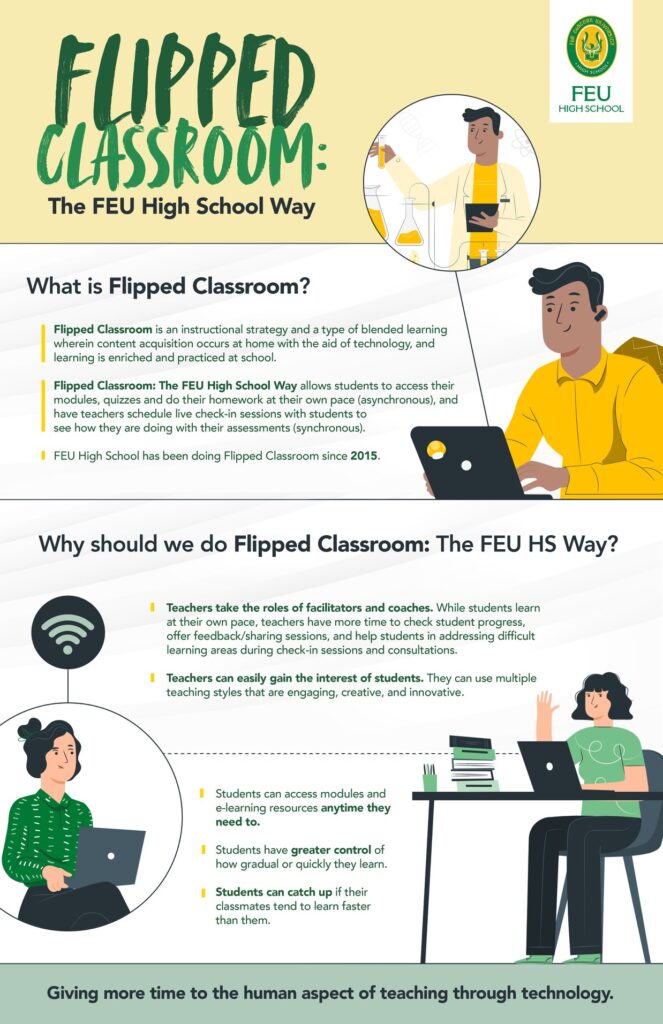Published: 11:11 am August 18, 2021 | Updated: 3:02 pm December 17, 2021
Last July 12, 2021, Ms. Shiela Dingcong introduced “The Flipped Class Approach and Social Constructivism” to the FEU high School Faculty. In this activity, the speaker emphasized that students are active creators of learning experiences. To become a learner-centered e-learning designer, teachers should shift their mindset, get to know their learners, rethink the learning objectives, and shift the balance of power.
The flipped classroom approach’s main goal is to expose the students to course content before they come to the class through readings and videos. It’s like a learning scaffolding, where the students learn the fundamentals of the lesson and then reinforce them with facts in the class discussions. It also objects to the fact that teachers are no longer the source of knowledge, but rather a facilitator of learning in an online environment. It encourages students to learn at their own pace while collaborating with other students and teachers through the use of technology. Students become active creators of their own learning, or, to put it another way, they learn by doing. In that case, learning is more likely to be retained in the students if they can experience and grasp it in their own unique way. Finally, the learned knowledge is contextualized in the learner’s environment.

The flipped classroom is critical in today’s educational environment, where the pandemic is still present. It is critical that learning facilitators be able to assist learners in contextualizing subject content in their environment. Flipped classroom helps the students to set their own pace of learning through social interaction with other students and educational online platforms, which provides them skill-based training that would build critical thinking and would progress into lifelong learning skills.
Last July 12, 2021, Ms. Shiela Dingcong introduced “The Flipped Class Approach and Social Constructivism” to the FEU high School Faculty. In this activity, the speaker emphasized that students are active creators of learning experiences. To become a learner-centered e-learning designer, teachers should shift their mindset, get to know their learners, rethink the learning objectives, and shift the balance of power. The speaker stressed out that learning requires social interaction that will help them acquire new knowledge. This interaction can be with peers, parents, and teachers. The speaker accentuated that learning is scaffolded, built upon past experiences and prior knowledge. There are milestones composed of the level of activities that students should achieve to be able to reach their goals and the teacher should act as a facilitator to let students apply new knowledge learned. Finally, the speaker highlighted that knowledge learned is contextualized in the learner’s environment. The teachers should make authentic assessments that acknowledge the work and effort of every student.
The speaker used the model of Salmon’s Five Stages of E-Moderating. In this approach, teachers should get the interest of students to actively partake in the electronic learning management system that the school is utilizing. Teachers may form group activities and facilitate the interactions of members in every group. Teachers may promote online socialization, teamwork, and leadership through group activities. Teachers may dive into the topics that students may talk about and get out of their shells. This should be practiced not just by letting the student speak during the synchronous session but also by operating discussion boards and conducting chats in asynchronous classes. Once the students acquired the concepts, the teachers should implement an activity where students can apply their learnings and appreciate how it reflects real-life situations.
In the last part of the activity, the speaker brought important people in transporting the quality of learning to students. They are the Instructor, Social Director, and Technical Assistant. Instructor act as consultant, guide, and resource provider. Instructors should be fostering learner-centeredness, structuring problem-based learning, and authentic work, and providing informative feedback. Social Director is the creator of collaborative environments. It should be promoting interpersonal relationships and helps learners work together, modeling interaction techniques, and encouraging and ensuring a high degree of interactivity and participation. Technical Assistant, on the other hand, is the model of proficiency. Technical Assistants should be helping learners become conformable of systems and software, preparing learners to resolve any technical difficulties that may occur, and maintaining effective facilitators to feel comfortable using media and communication tools.
In the unprecedented social disruption brought by the coronavirus disease 2019 (COVID‐19) pandemic, trying a new teaching approach and strategy may be frightening for some teachers. But on the brighter side, it has proved that teachers can take this as opportunity to be well-equipped and geared up as well in the needs of the learners in a time of major health risk and worldwide crisis. With a flipped classroom approach, teachers can be successful to utilize and maximize the demand of innovation in a changing circumstance. Flipped classroom can provide a concrete strategy to use innovation less pressuring for the students. It can replicate the positive outcome in face-to-face discussion and makes it less demanding and achievable.
